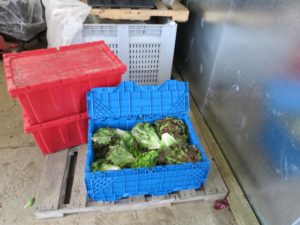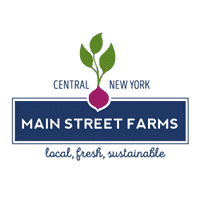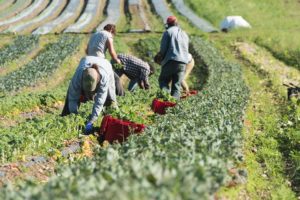Main Street Farms – Improving Efficiency and Profitability
Main Street Farms shares insights gained from their experience focusing on long-term business viability through a Profit Team project.
At Main Street Farms, in Cortland NY, growth is the way of doing business. The farm has doubled in size annually. What started as a 1-acre market garden and 10,000 tilapia in an aquaponics system is now, after six years, 30 acres on three properties and 25,000 square feet of high tunnels and greenhouses, producing vegetables for over 300 CSA members, one farmers market, area restaurants, and wholesale customers.
Given their rapid growth, one would never expect that farmers Allan Gandelman and BobCat Bonagura didn’t begin their business with agricultural backgrounds. Allan, a high school social studies teacher, left the education field for the farm field, with a goal of growing vegetables for the local community and children in area schools. Shortly after starting the business, he recruited college roommate BobCat from an outdoor environmental education field to join the farm. Both have a love of learning and are passionate about feeding the community and educating about local food. In 2016, products from the farm made it into the school where Allan once taught, fulfilling his aspirations to feed students nutritious local vegetables. Demonstrating their value of community engagement, the farmers have also served on various local agricultural and environmental boards, and offered classroom presentations and tours, in addition to participating in local school events.
Since its launch seven years ago, the farm has occupied about eight different properties; 2017 marked the first year that the farm has not moved one or more of its sites between seasons. With a long-term lease for land, Allan and BobCat now are focusing on modifying existing facilities and have leased a 4,000 square foot warehouse for post-harvest packing and cold storage, and a commercial kitchen for the farm and another local business.
Shortly after the farm launched, Allan recognized a need to scale up production in order to develop a sustainable operation. This need was informed by the evaluation of profit and loss statements, enterprise analysis of individual crops to determine profitability per foot, and time studies of labor use. With a local average household income of $30,000, Allan believed the pathway for growth was to produce and sell more volume of diverse vegetables, not just more high-profit specialty crops.
As a result, Allan applied to the Small Farm Program’s Profit Team Project to explore opportunities scale up the business. He elaborates that over time the focus has been to increase production so supply outweighs demand, increase CSA memberships, and create access to a reliable processing facility. To date, the profit team project has helped with this goal by providing support to visit six other farms to learn about systems and best practices, offset attorney fees for the land lease, and work with an outside consultant to apply for GAP certification.
The benefits from this project were numerous. The farm’s new packing shed and GAPS certification would likely not have happened as quickly without the support of the project. Within the past three years, Main Street Farms has also scaled up equipment, and transitioned from one 47 horse power Kubota to approximately 8 tractors to save labor and increase efficiency. Additionally, the farm has invested in a large high efficiency cooler, land lease, and two H2A laborers as a result of work on the profit team project.
Allan also notes that the project has impacted farm management, profit and quality of life. Over the course of the project, Allan used a portion of grant to visit, shadow and interview other regional, more experienced farmers. He was able to see how they operate, to learn their successes and mistakes, and by reflection, to identify inefficiencies and possible solutions for Main Street Farms. During these visits, Allan also discussed how data and financials, such as gross sales, employee pay, cash flow and debt, caninform the development of short- and long-term goals. These insights helped informed Allan’s decisions around infrastructure investments. Additionally, by seeing how others created a work-life balance, Allan learned strategies to implement on his own farm to support long-term quality of life improvements. He was inspired by one farmer who had established a structure so the farm family could take vacations every August, while others demonstrated strategies for balancing on- and off-farm work.
Looking to the future, Main Street Farms intends to continue following the plan it has set-forth, keeping a focus on establishing existing enterprises before expanding into new endeavors. “At this point, we just need to keep following the path that we have in front of us,” Allan notes, indicating the importance in staying focused and letting decisions play out. Allan’s next profit team project would be to focus on improving production and management practices to maximize profit. He would start by visiting larger growers. He notes that learning about business planning and technical expertise go hand in hand, as an organization scales up.

Main Street Farms now harvests lettuce from the field, packs it into crates, and stores it directly in the highly efficient cooler.
Photographer: Kat McCarthy
A Partial Budget to Understand Costs & Benefits
On a tour of another farm, Allan observed a useful strategy to address maintaining food quality and improving food safety, while improving handling efficiency. By using a high efficiency cooler, the host farm was able to cool lettuce and other greens from field with less handling. At the time, lettuce harvested at Main Street Farms was cooled by submerging in cold water, air dried, and then put in storage. This resulted in the produce having to be handled at least twice from the field to box, while potentially reducing produce quality. Additionally, cooling field grown produce to the right temperature in the right amount of time is key for food safety. Using the new method to keep lettuce cool; it could be directly transferred from the field to cold storage. By adopting this approach the farm was able to save 4-5 hours of labor per week on head lettuce alone. This strategy also improved product quality and has led to increased profitability in the farm’s greens enterprise.
To evaluate this new option, Main Street Farms had to analyze if the capital investment in the cooler would be offset by the reduced cost and increased revenue from the investment. For a relatively low capital investment like a walk-in cooler, one may choose to start with developing a partial budget (Table 1).
A partial budget looks at a potential change in a farm business to see if it makes sense financially. The additional costs of the potential change and any reduction in income are on one side of the budget. On the other side are any increase in income and reduced costs. These two columns are added together, and if the additional income and reduced costs are greater, it should result in additional profit for the farm. It is important to keep in mind additional uses for the investment, such as storing winter vegetables for a longer period of time. For longer term investments, one should allocate costs and income on an annual basis. For a more thorough analysis of capital investments, and for larger investments, it would be recommended to perform a net present value assessment. The example below shows how a partial budget could be used for buying a walk-in cooler.
| Partial Budget for Walk-in Cooler | |||
| Increase in Net Income | Decrease in Net Income | ||
| Item | Amount | Item | Amount |
| Improved Produce Quality | $750.00 | – | – |
| Decrease in Cost | Increase in Cost | ||
| Item | Amount | Item | Amount |
| Labor | $2,131.00 | Walk-in Cooler (annual) | $2,000.00 |
| Electricity Use | $250.00 | ||
| Total Increase | $2,881.00 | Total Decrease | $2,250.00 |
| Change in Net Income | $631.00 | ||
| Assumptions | |||
| Labor Savings: 5.5 hours/wk, $15.50/hr cost, 35 wk season | |||
| Walk in Cooler: $30,000 cost, 15 year life | |||
Strategies for Success
Allan offers this advice to farmers who are growing their business:
- Constantly seek new information and learn skills to support positive evolution. By meeting with outside consultants and shadowing other farmers, Allan was able to incorporate successful strategies from others, while tailoring techniques to meet Main Street Farm’s unique needs. In meeting with a farm in Pennsylvania, Allan discovered that by investing in a high efficiency cooler he could avoid washing heads of lettuce, reducing staff time, making GAPS compliance easier, and ultimately saving 30% on the production cost of the head of lettuce by reduced handling.
- Collect and use data to inform management decisions. For example, to understand the labor cost of a crop, Allan conducts studies where he times how long it takes an employee to handle (i.e. bunch, wash, etc.) a specific amount of a crop. Through these time studies, Allan understands labor costs for each product. As a result, the farm has a keen understanding of productivity metrics and costs. This data can be applied to conduct an enterprise analysis, which informs costs and payback period for investments in equipment.
- Network with other business owners, even if they are not farmers. For the past three years, Allan has been meeting monthly with a peer advisory group of other business owners in the local community, where they share and discuss their own business financials and numbers. He stated that “they are very valuable meetings and we haven’t missed one month since we started.” For example, at one of these meetings, Allan was posed with this question: Insurance companies send their customers a reoccurring bill, rather than stopping service for two seasons – so why not offer a year-round CSA to encourage customer retention? As a result, Main Street Farms is now operating a subscription “pay as you go” CSA for customers that doesn’t end in the fall, but instead continues until the customer cancels.
Kat McCarthy worked with the Beginning Farmer Profit Teams as the Beginning Farmer Project Coordinator for the Cornell Small Farms Program from March 2017 through May 2018. Dan Welch is the Business Planning Director at NY FarmNet and has been involved with the profit team project since 2015.
Information for this summary was collected in June 2017. For more information about the Profit Team Project, please visit https://smallfarms.cornell.edu/projects/profit-teams/.
This project was a collaboration of the Cornell Small Farms Program, NY Farm Viability Institute, and NY FarmNet, and made possible with funding from the National Institute of Food and Agriculture, U.S. Department of Agriculture, under award number 2015-70017-22882.



